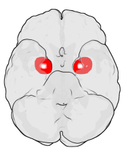
Amygdalohippocampectomy
Encyclopedia


Epilepsy
Epilepsy is a common chronic neurological disorder characterized by seizures. These seizures are transient signs and/or symptoms of abnormal, excessive or hypersynchronous neuronal activity in the brain.About 50 million people worldwide have epilepsy, and nearly two out of every three new cases...
. It consists of the removal of the hippocampus
Hippocampus
The hippocampus is a major component of the brains of humans and other vertebrates. It belongs to the limbic system and plays important roles in the consolidation of information from short-term memory to long-term memory and spatial navigation. Humans and other mammals have two hippocampi, one in...
, which has a role in memory, spatial awareness, and navigation, and the amygdalae, which have a role in the processing and memory of emotional reactions, both structures forming part of the limbic system
Limbic system
The limbic system is a set of brain structures including the hippocampus, amygdala, anterior thalamic nuclei, septum, limbic cortex and fornix, which seemingly support a variety of functions including emotion, behavior, long term memory, and olfaction. The term "limbic" comes from the Latin...
of the brain
Brain
The brain is the center of the nervous system in all vertebrate and most invertebrate animals—only a few primitive invertebrates such as sponges, jellyfish, sea squirts and starfishes do not have one. It is located in the head, usually close to primary sensory apparatus such as vision, hearing,...
.
Amygdalohippocampectomy is used only when all other treatment options have failed to resolve the epilepsy. It is an effective treatment for most patients. However, possible adverse side effects include impaired memory and defects in visual perception.
Procedure
The amygalohippocampectomy is indicated when the focal point of the seizures can be anatomically localized to the hippocampus and amygdala. Normally, to be considered for this procedure, one must have failed all first-line treatments. The selective amygdalohippocampectomy will remove only the offending portions of the hippocampus and amygdala. When data from studies of the electrophysiologyElectrophysiology
Electrophysiology is the study of the electrical properties of biological cells and tissues. It involves measurements of voltage change or electric current on a wide variety of scales from single ion channel proteins to whole organs like the heart...
and neuropathy vis-à-vis temporal lobe epilepsy
Temporal lobe epilepsy
Temporal lobe epilepsy a.k.a. Psychomotor epilepsy, is a form of focal epilepsy, a chronic neurological condition characterized by recurrent seizures. Over 40 types of epilepsies are known. They fall into two main categories: partial-onset epilepsies and generalized-onset epilepsies...
determines this area to be the origin of seizure activity, the removal of the hippocampus and amygdala is usually indicated. Computer imaging is sometimes used to guide this procedure. Patients continue normal activity after approximately six to eight weeks.
Statistics and side effects
Of 376 patients who had the amygdalohippocampectomy procedure performed, compared to other types of temporal lobe resections, two thirds of this population were reported free of disabling seizures.Some patients report defects in visual perception
Visual perception
Visual perception is the ability to interpret information and surroundings from the effects of visible light reaching the eye. The resulting perception is also known as eyesight, sight, or vision...
and impaired memory function.

